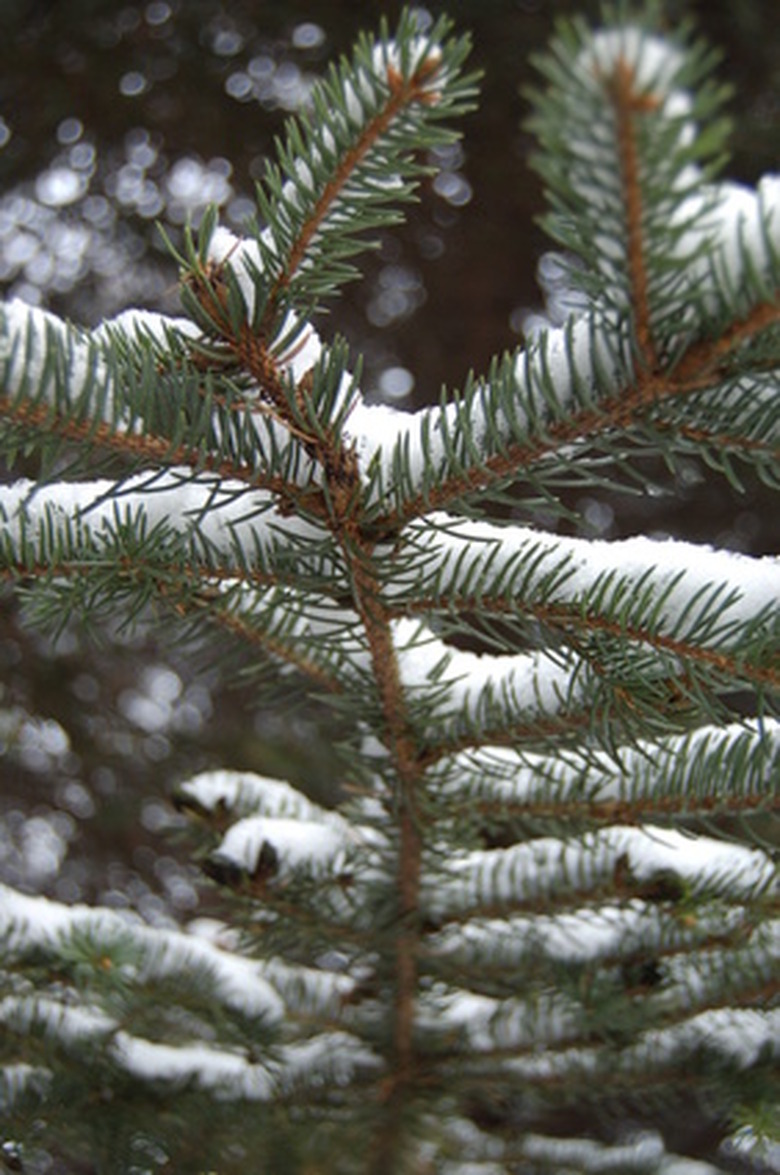The Best Arizona Outdoor Plants
Southern Arizona is a hot, dry place, occupying a portion of the Sonora Desert. Many types of palm trees grow well in the Phoenix and Tucson areas, as do cactus and many tropical plants. But the northern, mountainous regions of Arizona have much different climates, and some areas, such as around Flagstaff, receive snow in the winter. Your location will determine the plants you can successfully grow outdoors in Arizona.
Spruce for Cold, Mountainous Areas
Flagstaff, Greer and Window Rock are towns in Arizona's cold mountainous regions with elevations ranging from 6,000 to 8,000 feet. These areas receive only 20 to 25 inches of rain a year, and plant-killing frosts have occurred into the middle of June. The Picea species of spruce is a good outdoor plant for these cold areas. This evergreen tree is attractive and a common landscape tree in Arizona's colder areas. Resembling a pine tree, the Picea spruce also has seedpods similar to small pine cones. Plant spruce trees when they are 3 to 4 feet tall in areas where the soil remains moist. Early spring is the best time to plant a spruce. Provide enough space for your spruce tree because it will grow to 80 feet with a 1- to 2-foot diameter. A number of spruce trees planted in close proximity to each other can serve well as a windbreak. The spruce is easy to grow and only needs you to prune its lower branches when they begin to die.
- Southern Arizona is a hot, dry place, occupying a portion of the Sonora Desert.
- Many types of palm trees grow well in the Phoenix and Tucson areas, as do cactus and many tropical plants.
Crape Myrtle for High Desert Areas
The towns of Bisbee, Clifton, Globe, Douglas, Prescott, Sedona and Sierra Vista are in the high desert, with elevations ranging from 3,500 to 5,000 feet. Rainfall averages only 10 to 20 inches per year. Minimum winter temperatures usually hit the freezing mark, but throughout this area the crape myrtle will succeed. The crape myrtle is a medium-size, fast-growing tree with stunning flowers that range from white to deep scarlet, depending on the variety. All types of the crape myrtle are suited to USDA climate zones 7 through 10 and are drought tolerant. A variety called dynamite is the hardiest of the crape myrtles and is resistant to fungal diseases and many insects. It grows to 30 feet tall and has deep red flowers that remain for up to four months, making this tree a popular choice for lining driveways and roads. It will tolerate many types of soil and will thrive in full or partial sun.
- The towns of Bisbee, Clifton, Globe, Douglas, Prescott, Sedona and Sierra Vista are in the high desert, with elevations ranging from 3,500 to 5,000 feet.
- The crape myrtle is a medium-size, fast-growing tree with stunning flowers that range from white to deep scarlet, depending on the variety.
Jacaranda for Hot, Low Desert Areas
The towns of Phoenix, Yuma, Casa Grande, Florence, Chandler and Parker all lie in the low desert area of Arizona, which ranges in altitude from 1,000 to 2,000 feet. The growing season is long and the winter rarely sees temperatures lower than the mid-30s F. Summer temperatures often top the 100-degree mark. Less than 10 inches of rain falls each year in this area. The jacaranda is a heat-loving tree with fern-like leaves and sports a traffic-stopping array of lavender colored flowers in the summer. Native to subtropical areas of Central and South America, the jacaranda has proved itself a hardy, attractive addition to hot, dry climates of the American Southwest. It can reach a height of 30 feet under cultivation when grown in full sun and fertile soil. Water this tree or add a soil wetting agent to help retain moisture. It's a carefree tree that rarely needs pruning. After it is established, the jacaranda is frost tolerant, but protect it when it is young. Jacarandas can take up to five years after planting to produce their lovely flowers.
- The towns of Phoenix, Yuma, Casa Grande, Florence, Chandler and Parker all lie in the low desert area of Arizona, which ranges in altitude from 1,000 to 2,000 feet.
- The jacaranda is a heat-loving tree with fern-like leaves and sports a traffic-stopping array of lavender colored flowers in the summer.
Bougainvillea for Phoenix
Other smaller subtropical plants such as the vining bougainvillea are popular choices for homes in the Phoenix area. With nearly year-round blooms, this hardy plant will tolerate full sun and hot temperatures. It normally is not damaged by frost unless the temperature drops below 32 degrees F. Bougainvillea is a good choice for the sides of fences, garages and outbuildings because it will grow tall and cover unattractive areas while receiving support from the structure upon which it grows.
